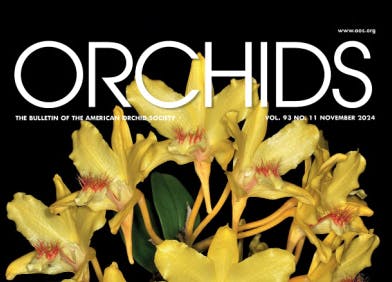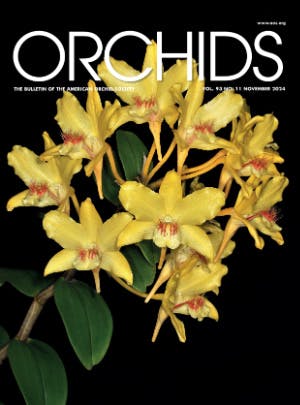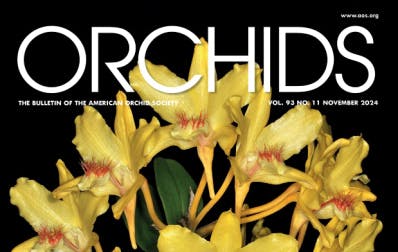
Among the many sections in the genus Dendrobium, I believe that section Formosae has some of the most outstanding examples of orchid flowers. For the most part, the sepals and petals are a pristine white, and the labellum may have colored blotches, stripes and markings. There are a few members of the section whose flowers are green with vivid red markings on the labellum, a most stunning color combination. Another group has pale yellow to cream flowers with reddishorange markings on the labellum.
Section Formosae was first mentioned by George Bentham and Joseph Hooker in 1883 in Genera Plantarum 3. In 1890, Joseph Hooker named it as a section of the genus Dendrobium in his Flora of British India, volume 5. The name refers to the extraordinary beauty of the flowers. Members of this section can be distinguished by the indumentum (short, usually black hairs) that, in some species, are on the leaf sheaths, the undersurface of the leaves, or on the new growths. The type species for the section is Dendrobium formosum Roxb.
DENDROBIUM CARINIFERUM
Heinrich G. Reichenbach named this species in 1869 in the Gardeners’ Chronicle. The specific epithet refers to the ridges on the labellum. The plant reaches lengths of 16 inches (40 cm). Inflorescences are short and can have up to five flowers up to 2 inches (5 cm) in diameter. This species has been found in Myanmar, Thailand, Laos, Vietnam and Cambodia, where it grows as an epiphyte at elevations of about 5,000 feet (1,500 m).
DENDROBIUM CRUENTUM
Heinrich G. Reichenbach named this species in 1884 in the Gardeners’ Chronicle. The specific epithet refers to the blood-red coloration on the labellum. The plant is an upright grower reaching 18 inches (45.7 cm) in height. Inflorescences bear one or two flowers about 1½ inches (3.8 cm) in diameter. This species is recorded from peninsular Thailand and possibly Myanmar. It grows at elevations to 3,000 feet (916 m).
[1] The sepals and petals of Dendrobium cruentum can vary from almost white, through cream and green shades. The greenish form was grown and photographed by Ronny Boos. The inset photograph is of a plant photographed by the author.

[2–6] The lip of Dendrobium bellatulum can vary from dark red-orange to yellow and even bicolor forms are known. Growers: [2] Jim Cootes, [3] Doug Kubo, [4] Joe Marinello, [5] Marni Turkel, [6] Jeff Tyler.





[7] Dendrobium cariniferum

DENDROBIUM DRACONIS
Heinrich G. Reichenbach named this species in 1862 in Botanische Zeitung (Botanical Newspaper). The specific epithet means “dragon-like,” but I am not sure to which aspect of the flower this refers. Plants reach 2 feet (30 cm) in height. Inflorescences can have up to three flowers up to 2½ inches (6.4 cm) in diameter. This species is widespread and has been recorded from northeast India, Myanmar, Thailand, Vietnam, Laos, Cambodia and China. It grows as an epiphyte at elevations of about 4,000 feet (1,220 m).
DENDROBIUM FORMOSUM
William Roxburgh named this species in 1832 in Hortus Bengalensis (Garden of Bengal). The specific epithet refers to beautiful, or handsome, flowers. Plants can reach 18 inches (45.7 cm) tall. Inflorescences can have from two to four blooms, 3–5 inches (7.6–12.7 cm) in diameter. This species is found in the foothills of the Himalayan Mountains, India, Nepal Bhutan, Myanmar, Thailand and the Andaman Islands. It grows from sea level to about 1,700 feet elevation (0–519 m).
DENDROBIUM INFUNDIBULUM
John Lindley named this species in 1858 in the Journal of the Proceedings of the Linnean Society. The specific epithet refers to the funnel-like mentum (spur). Plants can get to 15 inches (38 cm) in height. Inflorescences are usually two-flowered, and flowers can reach 4 inches (10 cm) in diameter. It has been recorded from northeast India, Myanmar, northern Thailand and Laos, where it grows at elevations of around 8,000 feet (2.440 m).
[8–11] Representative clones of Dendrobium draconis; [8] was grown by Cynthia Hill, the growers of [9] and [10] are unknown, [11] was grown by the author. Photographs [8–10] by Ron Parsons, [11] taken by the author.
[12–13] Dendrobium formosum. Both photographs by the author.
[14] Dendrobium infundibulum photographed by the author.

DENDROBIUM LONGICORNU
John Lindley named this species in 1829 in A Numerical List of Dried Specimens of Plants in the East India’s Company Museum. The specific epithet refers to the long column foot. Plants can get to 16 inches (40.6 cm) in height. Inflorescences can have from one to three flowers about 2 inches (5 cm) in diameter, which do not open widely. It is known to occur in the central Himalayas, India, Nepal, Bhutan and China, where it grows on both trees or rocks at elevations of 4,000–8,000 feet (1,220–2,440 m).
[15–16] The flowers of Dendrobium longicornu vary from white with pale yellow lips through yellowish forms whose lips are a rich, dark red-orange. Both photographs were taken by the author.


DENDROBIUM LOWII
John Lindley named this species in 1861 in the Gardeners’ Chronicle. The specific epithet honors Sir Hugh Low, whose father established a plant nursery at Clapton in east London. The plant can reach 20 inches (51 cm) in height. Inflorescences can carry up to four flowers about 2 inches (5 cm) in diameter. It is endemic to Borneo and grows at elevations of around 3,000 feet (916 m).
DENDROBIUM OVIPOSTORIFERUM
Johannes J. Smith named this species in 1912 in Botanische Jahrbücher fur Systematik, Pflanzengeschichte, und Pflanzengeographie (Botanical Yearbooks for Systematics, Plant History, and Plant Geography). The specific epithet refers to the shape of the mentum (spur). Plants can reach a height of 2 feet (61 cm). The inflorescences can have up to five blooms about 2¼ inches (5.7 cm) in diameter. This species is endemic to Borneo, where it grows at elevations to 2,000 feet (610 m).
[17–19] Flowers of Dendrobium lowii vary from deep, intense yellow through paler shades of yellow and greenish-yellow. Photograph [17], taken by Ron Parsons, is of a plant grown by Cynthia Hill. Ravan Schneider grew and photographed [18] and [19].
[20–22] Flowers of Dendrobium ovipostoriferum vary in the brightness of the sepals and petals and lip intensity as well as the glossy texture of the sepals and petals. All three photographs were taken by Ron Parsons; [20] was grown by Darwin Harrison, [21] by Ron Parsons and [22] by Marni Turkel.

DENDROBIUM TRIGONOPUS
Heinrich G. Reichenbach named this species in 1887 in the Gardeners’ Chronicle. The specific epithet refers to the triangular column foot. Plants are small, growing only about 6 inches (15 cm) in height. Inflorescences bear up to three flowers, 2 inches (5 cm) in diameter. Found in Myanmar, northern Thailand and China at elevations of about 6,000 feet (1,832 m).
DENDROBIUM VALMAYORAE
Danny Tiu named this species in 2009 in the Philippine Orchid Review. The specific epithet honors Helen Valmayor, who did much to popularize orchid growing in the Philippines. Plants are upright growers reaching 14 inches (35.6 cm) in height. Inflorescences are short and bear up to three flowers up to 2 inches (5 cm) in diameter. This species is endemic to the island of Mindanao in the Philippines, where it grows at elevations of around 2,000 feet (610 m).
[23–26] Dendrobium trigonopus; [23–24] grown by Cynthia Hill and photographed by Ron Parsons, [25] grown by Marni Turkel and photographed by Ron Parsons and [26] photographed by the author.
[27] Dendrobium valmayorae grown and photographed by Ben Mabanta.

DENDROBIUM VIRGINEUM
Heinrich G. Reichenbach named this species in 1884 in the Gardeners’ Chronicle. The specific epithet refers to the pure-white flowers. Plants can be up to 16 inches (40.6 cm) in height. Inflorescences have up to six flowers about 1½ inches (3.8 cm) across. This species has been recorded from Myanmar, northern Thailand, Vietnam and Laos, where it grows at elevations of between 1,000 and 3,000 feet (305–916 m).
DENDROBIUM WATTII
Heinrich G. Reichenbach named this species in 1888 in the Gardeners’ Chronicle. The specific epithet honors Dr. Watt, a British botanist at the time. Plants grow to 2 feet (60 cm) in length. Inflorescences bear several flowers up to 2 inches (5 cm) in diameter. This species is known to occur in northeast India, Myanmar, Thailand, Vietnam and China. It grows as an epiphyte at elevations of between 5,000 and 7,000 feet (1,527– 2,137 m).
DENDROBIUM WILLIAMSONII
John Day and Heinrich G. Reichenbach named this species in 1869 in the Gardeners’ Chronicle. The specific epithet honors Mr. W.J. Williamson, collector of the type specimens. The short-growing plant only reaches 12 inches (30 cm) in height. The inflorescences have up to three flowers up to 2¼ inches (5.7 cm) in diameter. This species has been recorded from India, Myanmar, Thailand, Vietnam and China. It grows at elevations of about 1,000 feet (305 m).
[28–29] Dendrobium virgineum. Picture [28] was grown by Cynthia Hill and photographed by Ron Parsons; the author photographed [29].
[30] Dendrobium wattii
[31–34] Representative clones of Dendrobium williamsonii; [31], grown by Hanging Gardens and [32], grown by Judy Carney, were photographed by Ron Parsons. [33] and [34] are photographs by the author




Acknowledgments
Sincere thanks to Ronny Boos (Philippines), Ron Parsons (United States) and Ravan Schneider (Germany) for allowing me the use of their pictures to further enhance this article.
Further Reading
Beentje, H. 2010. The Kew Plant Glossary, an Illustrated Dictionary of Plant Terms. Kew Publishing, Royal Botanic Gardens, Kew, United Kingdom.
Cootes, J. 2011. Philippine Native Orchid Species. Katha Publishing, Manilla, Philippines.
Gale, S., P. Kumar P. and T. Phaxaysombath. 2018. A Guide to Orchids of Laos. Natural History Publications (Borneo), Kota Kinabalu, Borneo.
Lavarack, P.S., W. Harris and G. Stocker. 2000. Dendrobium and Its Relatives. Timber Press, Portland, Oregon.
Seidenfaden, G. and J.J. Wood. 1992. The Orchids of Peninsular Malaysia and Singapore. Olsen & Olsen, Fredensborg, Denmark.
Wood, H.P. 2006. The Dendrobiums. A.R.G. Gantner Verlag, Ruggell/Liechtenstein.
Wood, J.J. 2014. Dendrobium of Borneo. Natural History Publications (Borneo) in association with Kew Royal Botanic Gardens, Kota Kinabalu, Borneo.












